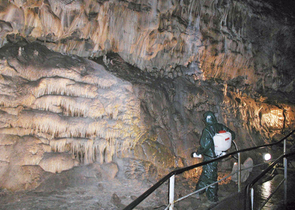The Journal is published by the Nature Conservation Agency of the Czech Republic in cooperation with the Cave Administration of the Czech Republic, the Krkonoše Mts. National Park Administration, the Bohemian Forest Mts. National Park Administration, the Podyjí National Park Administration and the The Bohemian Switzerland National Park Administration. It has been published since 1946.
cs / en
Nature Conservation 5/2013 — 30. 11. 2013 — Research, Surveys and Data Management — Print article in pdf
Hebelka J.: Lampenflora Removal and Eradication from the Moravský kras/Moravian Karst Show Caves
v jeskyních Moravského krasu

The author describes measures taken to remove and to eradicate lampenflora (a community consisting of various lower plant species occurring in close or remote proximity to artificial light sources, e.g. lamps) in four show caves in the Moravský Kras/Moravian Karst.
Lampenflora growths, particularly algae, cyanobacteria often called blue-green algae, mosses or bryophytes, ferns, only exceptionally vascular plants) produce humic acids, which can irreversibly damage karst ornaments. Effectiveness of mechanical measures, e.g. using brushes and pressured water which started to be applied in the late 1970s has proved to be very low. Their main disadvantages include both possibility of further lampenflora spreading in spaces not penetrated yet and mechanical damage of walls and sinters. Another method displaying quite high effectiveness uses ultraviolet radiation. Moreover, a short range is a limiting factor: UV radiation emitted by a 30 W lamp is effective maximally within the distance of 50–70 centimetres. Thus, further methods can involve chemicals, but their possible affects on cave ecosystems should be carefully assessed. In the late 1970s, sodium hypochlorite Ca(ClO)2x 2H2O and sodium hypochlorite NaClO were tested in the Moravský kras/Moravian Karst caves. Later, tests with chlorinated lime were also performed. When the 4% solution was repeatedly, namely three times applied, the treatment was effective. In 1984–1990, 10–15% chloramines-T solution was used: the chemical substance is, in comparison with chlorinated lime, less toxic and better soluble in water. Since 1991, 4% sodium hypochlorite solution has been applied: at present, it is the most effective agent in lampenflora removal and eradication. In addition, since 1994 experiments with hydrogen peroxide (H2O2) which is more cave environment friendly have been also carried out. Moreover, it was confirmed that hydrogen peroxide is not as effective as hypochlorite mixtures and the results are even after repeated applications not unambiguous.

